Differentiating Instruction for Mixed-Ability Classes
Share
Catering to diverse learning needs is essential to ensure every student is engaged and progressing at their own level. Differentiation allows for a more inclusive classroom where all students feel challenged and supported. Here are some effective strategies:
- Flexible Grouping: Rotate students into different ability-based or mixed-ability groups depending on the task. This allows students to work at an appropriate challenge level while also benefiting from peer collaboration. Regularly changing groups can expose students to different perspectives and skill levels.
- Choice Boards: Offer various activities so students can choose based on their strengths. This approach fosters independence and motivation by giving students ownership of their learning. Activities can be structured around different learning styles, such as visual, auditory, and kinaesthetic options.
- Tiered Assignments: Modify tasks so all students can access the learning at their level. For example, while one group might work on simple comprehension questions, another could be analysing a text in depth. Providing different levels of challenge ensures that all students are engaged without feeling overwhelmed.
- Scaffold Learning: Provide extra support, such as sentence starters, guided practice, or visual aids, for students who need it. Gradually reducing support over time helps students build confidence and independence. Encouraging peer support can also aid scaffolding.
- Use Peer Support: Encourage peer tutoring to foster collaboration and shared learning experiences. Pairing students of different abilities allows for mentorship and reinforcement of concepts. Structured peer discussions can help consolidate learning while promoting social skills.
